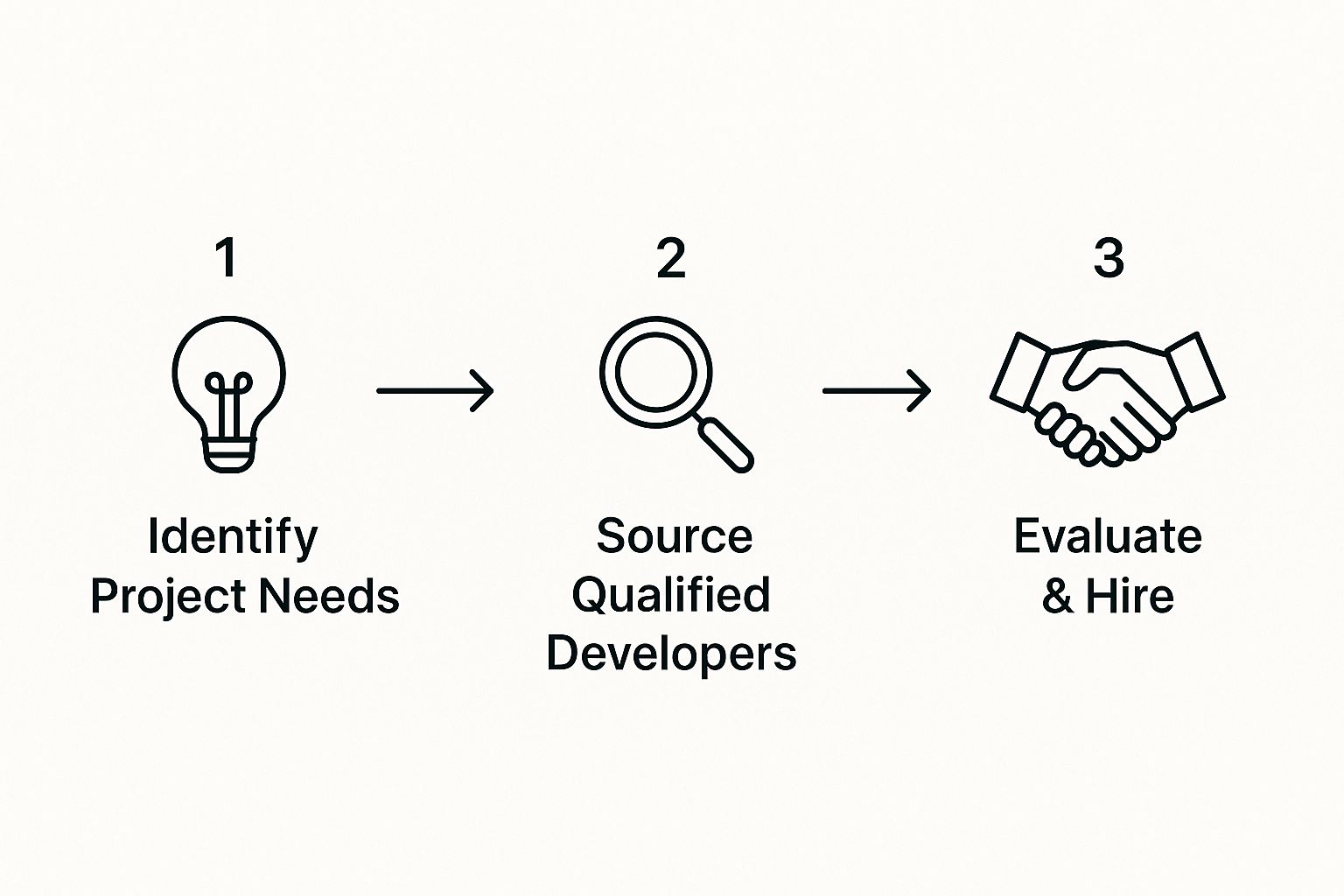Before you even dream about finding the perfect developer, let's get one thing straight: the success of your WordPress project is won or lost long before you post a single job ad.
A vague idea is a recipe for a chaotic project. A well-defined brief, on the other hand, is the map that guides a developer to build exactly what you need. This initial planning is non-negotiable if you want to hire a WordPress developer who actually delivers on time and within budget.
Laying the Groundwork Before You Hire
Rushing into the hiring process without a clear plan is the most common mistake I see. It’s a fast track to scope creep, blown budgets, and a whole lot of frustration. Before you even think about writing a job post, your first task is to translate your vision into a concrete document—a project brief.
This brief becomes the single source of truth for you and any developer you talk to. The process of creating it forces you to think through every corner of your project, from the big-picture goals down to the tiny details. This clarity is invaluable. It ensures the quotes you get are accurate and comparable because everyone is bidding on the exact same set of requirements.
Define Your Project's Core Components
So, where do you start? Begin by outlining the absolute essentials. A strong brief clearly states your objectives, who your target audience is, and the specific problems your website needs to solve. If you want to get really granular on this, our guide on requirements gathering techniques offers some fantastic, practical strategies to make sure nothing gets missed.
From there, you need to list out the key features and functionality you need. Think in terms of specifics:
- E-commerce capabilities: Are you planning to sell products? You'll likely need something like WooCommerce.
- Custom plugin needs: Is there a unique feature you need that an off-the-shelf plugin just can't handle?
- Third-party integrations: Does the site need to shake hands with your CRM, email marketing tools, or specific payment gateways?
- Design and branding guidelines: Do you have mockups, wireframes, or even just a list of websites you love the look of? Provide them.
Building a comprehensive brief can feel daunting, but it doesn't have to be. This table breaks down the essential pieces you'll want to include to attract top-tier talent.
Key Components for Your WordPress Project Brief
| Component | What to Include | Example |
|---|---|---|
| Project Overview | A short summary of your business and the project's main goal. | "We're a local bakery looking to build an e-commerce site to sell our goods online and manage local deliveries." |
| Target Audience | Who is this website for? Describe your ideal customer. | "Our primary audience is busy professionals aged 25-45 who value high-quality, artisanal baked goods." |
| Key Features | A bulleted list of essential functionalities. | "Online ordering system, integration with Stripe, custom delivery date picker, weekly specials feature." |
| Technical Specs | Any known technical needs or preferences. | "The site must be built on the Genesis Framework and needs to integrate with our existing Mailchimp account." |
| Design & Branding | Links to your brand guide, mockups, or inspiration sites. | "Please follow our attached brand guide for colours and fonts. We like the clean aesthetic of example.com." |
| Budget & Timeline | Your estimated budget range and ideal launch date. | "We have a budget of ₹50,000 – ₹75,000 and would like to launch within 8 weeks." |
Having these components clearly defined will make the entire hiring process smoother and more effective.
The journey to hiring the right WordPress developer follows a pretty clear path, from initial planning all the way to the final selection.

As this roadmap shows, identifying your needs isn't just a step—it's the foundation of everything that follows. With a solid brief in your hands, you’re in the perfect position to attract and hire a WordPress developer who is a genuine fit for your project.
Finding Top WordPress Talent in India

With your project brief locked in, it’s time to start the search. India has an absolutely massive talent pool, but knowing where to cast your net is the key to finding a real professional and avoiding the headaches that come with low-quality marketplaces.
Global freelance platforms like Upwork and Freelancer are usually the first stop for many. They give you access to a huge number of candidates at competitive prices, complete with built-in review systems. The flip side? The sheer volume can be overwhelming. The responsibility falls squarely on you to meticulously vet every single applicant because the quality can be all over the map.
Exploring Professional and Local Channels
If you're looking for a more curated approach, professional networks like LinkedIn are gold. A simple search for "WordPress Developer" filtered by location in India lets you browse detailed profiles, work histories, and recommendations. This channel tends to attract more established pros who aren't necessarily grinding it out on crowded freelance sites.
You also shouldn't overlook specialised Indian job boards like Naukri.com or Indeed India. Posting a detailed job description here can pull in developers who are looking for stable, long-term projects. The trick is to write a post that really sells your project’s challenges and growth opportunities, making it stand out from the hundreds of generic listings.
Tapping into local communities can uncover hidden gems. Developers who attend WordPress meetups in cities like Pune, Mumbai, or Bengaluru are often deeply passionate and continuously improving their craft outside of their day jobs.
Where to Look: A Quick Comparison
| Platform | Best For | Potential Drawback |
|---|---|---|
| Upwork/Freelancer | Short-term projects, budget-conscious hiring | High volume of applicants, variable quality |
| Finding experienced, long-term professionals | Slower response times, less transactional | |
| Indian Job Boards | Sourcing full-time or contract-based talent | May attract fewer freelance specialists |
| Local Meetups | Discovering passionate, community-involved developers | Less scalable, requires more direct networking |
In the end, a multi-channel approach is almost always the most effective strategy. Whether you decide to engage a freelancer or partner with a dedicated website and app development company, spreading your search across different platforms seriously boosts your chances of finding that perfect match. When you hire a WordPress developer, focusing your energy on quality sources right from the start will save you a ton of time and effort down the line.
How to Evaluate Portfolios and Technical Skills
A flashy portfolio looks great, but it only ever tells you half the story. To really figure out if a candidate has what it takes, you’ve got to dig deeper than the surface-level polish and see what’s going on under the hood. The goal here is simple: you need to separate the theme customisers from the genuine developers who can build real, complex solutions.
Start by getting your hands on their live projects. Don't just glance at the design; pull the sites up on your phone and see how they perform. Is it fast? Is it responsive? A slow or clunky mobile experience is a huge red flag, especially since over 60% of all web traffic is now mobile.
Ask them to walk you through one of their past projects. Get them talking about the specific problems they ran into and, more importantly, how they solved them.

A profile like this gives you a decent starting point, but your real evaluation needs to go much further.
Assessing Deeper Technical Expertise
Beyond the visuals, you need to get a feel for how well they understand WordPress architecture. If your project needs any unique features, you'll want to see if they have experience in creating custom WordPress plugins. That’s a clear sign they can build solutions from the ground up, not just assemble pre-made parts.
When you get them on a call, hit them with some specific, process-oriented questions. You're looking for substance, not just buzzwords.
- Performance: "Beyond installing a caching plugin, what's your approach to optimising a site for speed?"
- Security: "What are the first three things you do to lock down a brand new WordPress installation?"
- Version Control: "Do you use Git for your projects? Talk me through your typical workflow."
A great developer won't just list off a bunch of tools; they’ll explain why they use them. Their answers will tell you everything you need to know about their depth of knowledge and whether they follow modern best practices—which is essential when you hire a WordPress developer for a serious project. It's their thought process, not their project list, that reveals their true expertise.
Understanding Developer Rates in India

Trying to figure out developer rates can feel like a bit of a guessing game, but it doesn't have to be. When you hire a WordPress developer in India, the costs are shaped by a pretty standard set of factors: their experience, how complex your project is, and how you decide to work together.
A junior developer tweaking a basic theme is obviously going to have a different rate than a senior engineer building a massive e-commerce site with custom API integrations. In the same way, a one-off project with a fixed price is budgeted differently from a long-term retainer for ongoing support and updates. Getting your head around these differences is the first real step to setting a budget that makes sense.
Breaking Down the Numbers
Looking at compensation trends, you'll see a pretty wide spectrum. Research shows the average base salary for a WordPress developer in India is around ₹3,40,998 per year. Those just starting their careers usually earn about ₹3,24,270, while developers with 5–9 years under their belt see that average climb to ₹4,79,323. The top earners can pull in salaries up to ₹8,70,000, which really shows how much expertise can impact the cost.
This data highlights a simple truth: you get what you pay for. While those rock-bottom hourly rates on freelance sites can look appealing, they often come with less experience, which can lead to delays and quality headaches down the road.
Investing in a mid-level or senior developer often provides a better return. Their efficiency and ability to solve complex problems without extensive hand-holding can save you significant time and money over the project’s lifecycle.
Hourly vs Fixed-Price Projects
Choosing the right pricing model is also a big piece of the puzzle. Your decision should really match the nature of your project.
- Hourly Rates: This is your best bet for projects where the requirements might change or for ongoing maintenance. It gives you flexibility, but you'll need to keep a close eye on hours to manage the budget.
- Fixed-Price Projects: This is perfect for work with a very clear, well-defined scope. You get cost certainty from the start, but it's much less adaptable if you need to make changes.
Understanding these pricing structures is just as important as knowing the rates themselves. For a deeper dive into how different project factors shape the final price tag, our article on custom software development costs has some great insights. Setting a fair budget based on these market realities will help you attract and land the right talent for your needs.
Ensuring a Successful Project Kickoff
Hiring a developer and signing the contract isn't the finish line—it's the starting gun. That initial onboarding phase is the bedrock of a successful partnership, setting the tone for the entire project. A messy start almost guarantees delays, misunderstandings, and friction down the road.
On the other hand, a structured kickoff gets your new developer up and running from day one. It’s about more than just handing over logins; it’s about aligning on the vision, the process, and how you'll communicate. A little time invested here pays off big time by preventing costly rework later.
Creating a Seamless Onboarding Checklist
The best way to get things moving is to have all the necessary assets and access credentials organised before your first official meeting. It’s a simple step, but it shows you're professional and removes any immediate roadblocks for your developer.
Before they even start, make sure you can grant them access to:
- Hosting and Domain: Have the login details ready for your hosting control panel and domain registrar.
- WordPress Admin: Create a new administrator account specifically for them.
- Design and Content Files: Get links to your Figma mockups, brand guidelines, and any copy ready to go in a shared drive.
- Essential Tools: Add them to your project management software (like Trello or Jira) and your team communication channels (like Slack).
A well-organised kickoff isn't just a meeting; it's a strategic alignment. Clearly defining milestones, communication protocols, and success metrics upfront eliminates ambiguity and ensures everyone is working towards the same goals from day one.
Running an Effective Kickoff Meeting
The kickoff meeting is your chance to formalise expectations. Don't just wing it—use a clear agenda to guide the conversation. This is where you'll confirm key project milestones and establish a rhythm for regular check-ins, whether that means quick daily stand-ups or more detailed weekly progress reports.
You'll also want to nail down the preferred methods for communication. For example, agree that urgent issues get handled via a direct message, while general project updates are posted in a shared channel. Clarifying these small details prevents a world of confusion later and builds a solid foundation for a productive, long-term collaboration.
Common Questions About Hiring Developers
When you start the process of hiring a WordPress developer, a few key questions almost always bubble up. Getting clear answers to these early on helps you make confident decisions instead of falling into common traps that can derail a project before it even gets going.
Let's walk through some of the most frequent things that come up.
One of the first big decisions is whether to hire a freelancer or go with an agency. A freelancer can be a great fit for smaller, well-defined tasks, often bringing more flexibility and a lower price point to the table. An agency, on the other hand, comes with a full team—project managers, designers, and multiple developers. This provides a much more structured, end-to-end service that’s ideal for larger, more complex builds.
What About Ongoing Costs?
This is a big one. Your website isn't a one-time purchase; it's a living asset that needs regular care to keep it secure and running smoothly. Budgeting for ongoing maintenance is absolutely critical.
Think of it like owning a car. You wouldn't buy one and then be surprised by the cost of petrol, insurance, or regular servicing. Your website is the same—it needs updates, security monitoring, and backups to function properly.
A good rule of thumb is to set aside 10-15% of your initial development cost for annual maintenance. This ensures your investment is protected and performs at its best long after the launch day.
Your contract is the most important safety net for your project. Make sure it clearly spells out the full scope of work, project milestones, payment schedules, and—crucially—who owns the intellectual property when the work is done. This simple document is the best way to prevent misunderstandings and protect both you and your developer.
How Much Should I Expect to Pay in India?
To set a realistic budget, you have to know the local market rates. In India, salaries for WordPress developers can vary quite a bit based on their skill level and years of experience.
The average salary is around ₹4,00,000 per year. Entry-level roles might start closer to ₹3,00,000, while senior developers with a proven track record can earn upwards of ₹8,90,000.
It's also worth noting that mid-level developers, those with 5–9 years of experience, typically earn nearly 60% more than their junior colleagues. This jump shows just how much value the market places on proven, hands-on expertise. You can learn more about developer salary trends in India to get a better handle on your budget.
At KP Infotech, we connect you with vetted, dedicated WordPress developers who can turn your vision into a reality, ensuring your project is built for performance and growth from day one. https://kpinfo.tech
